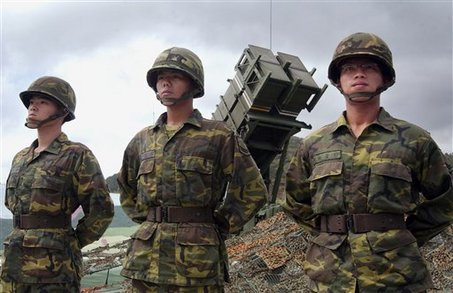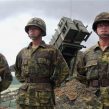
An Assessment of Taiwan’s Quadrennial Defense Review
Publication: China Brief Volume: 9 Issue: 8
By:

The Ministry of National Defense (MND) of Taiwan released its maiden “Quadrennial Defense Review" (QDR) on March 16. The report was warranted under provision Article 31 in Taiwan’s National Defense Act—which was passed in 2008—and conducted by the Integrated Assessment Office of the MND. The report has to be submitted to the Taiwanese parliament (Legislative Yuan) for review within 10 months of each presidential inauguration. The purpose of the QDR is to outline the country’s strategic defense vision for the four-year term of the Taiwanese presidency.
The first publication of the QDR has three major implications for the future of Taiwan’s defense and civil-military relations: Firstly, Taiwanese President Ma Ying-jeou’s guidance on national defense has been embodied in MND policy planning, thereby solidifying civilian control over the Taiwanese military. Secondly, the QDR consolidates the country’s strategic planning system, since the QDR follows the president’s guidance and provides directions for its defense strategy and military buildup. Finally, the first QDR establishes a four-year periodic review mechanism and institutionalized comprehensive review of major policies by the MND that articulate the vision for future development and reforms of Taiwan’s armed forces.
According to this author’s observation, who served as the former defense minister of Taiwan, the overwhelming majority of Taiwanese people’s views toward the country’s national defense strategy rests on the following three principles: First of all, to maintain the peace and security across the Taiwan Strait; two, to safeguard the sovereignty of Taiwan and territorial defense; and three, to protect people’s life and property in Taiwan.
The QDR is based on the core vision of building a professional armed force and maintaining peace across the Taiwan Strait—with sound strategic logic for future strategic environment analysis, strategic examination, organizational re-engineering, force planning and resource utilization. The QDR is composed of four chapters: core defense challenges, strategic guidance, defense transformation and joint war-fighting capabilities development.
All-Volunteer Force
The QDR outlines the Ma administration’s plan to institute an all-volunteer force (AVF) by 2014 (based on Chapter 3). China, however, continues to refuse renouncing the use of force to resolve the ongoing political dispute between Taiwan and China. Absent is the assurance from Beijing over the intent of its rapid military modernization, Taiwan’s defense planners need to exercise more caution, retain sufficient and effective force capability to insure Taiwan’s national security. Taking into consideration the systematic reduction of compulsory military service undertaken by the previous Taiwanese administration, mandatory military service, which has been in place since 1944, is a means for Taiwan to ensure an active force for its defense capability and a level of national alert for contingency planning.
In addition, the QDR’s proposal to move toward an AVF warrants further scrutiny on the basis that it requires a massive budget. The transformation may increase Taiwan’s defense budget by more than 20 billion NT-dollars (approximately $600 million), an estimate by a former senior advisor of Taiwan’s National Security Council (NSC). If the current administration in Taipei rushes through this proposal to move toward an AVF system, it will put an enormous financial strain on Taiwan’s national security structure.
In order to follow the QDR’s strategic guidance “Resolute Defense, Effective Deterrence" (fangwei gushou, yousiao siazu), Taiwan has to strengthen its defense capacity to resist any enemy’s attack. In terms of the enforcement of “Effective Deterrence,” the QDR indicates that strategic defense is in actual planning and concrete measure for the realization of a “Hard ROC (Republic of China)” defense. The specific strategic objectives are “war prevention,” “homeland defense,” “contingency response,” “conflicts avoidance,” and “regional stability” (based on Chapter 2).
In view of the People’s Liberation Army’s (PLA) massive military build-up along its coastal areas across the strait, the author believes that Taiwan needs to set up an effective defense-guided missile system in order to deter the enemy’s belligerence, and minimize damages caused by an enemy’s attack. In addition, Taiwan has to reorganize its military strength, and improve its systematic fighting capacity of joint operation so as to defend national security and stability in the region.
It is important to point out that Taiwan’s QDR is influenced by the main argument of the “Murray Report,” which stated, “Taipei can no longer expect to counter Chinese military strengths in a symmetrical manner. Taiwan must therefore rethink and redesign its defense strategy, emphasizing the asymmetrical advantage of being the defender, seeking to deny the People’s Republic its strategic objectives rather than attempting to destroy its weapons systems.” The "Murray Report" recommends that Taiwan should forego naval and air superiority, digging in and relying on passive defense by ground forces. Nevertheless, air and maritime forces still play critical roles in the defense of Taiwan. Given the substantial imbalances in the defensive and offensive strengths between Taiwan and China, respectively, effective air and maritime defense capabilities are still a critical deterrent for the self-defense of Taiwan. Accordingly, the "Murray Report" should not be taken as the blueprint of instructing Taiwan’s national defense strategy. The government needs to show determination in strengthening Taiwan’s overall defense capabilities so that the Taiwanese people can be reassured that a Chinese invasion would be met with an effective Taiwanese counterforce.
Military Confidence Building Measures
The proposal for a military “Confidence Building Mechanism" (CBM) can positively affect cross-Strait relations. Yet, for the sake of defending Taiwan’s national security, there are several significant conditions to iron out before the two sides sit at the negotiation table.
First of all, China ought to respect the status quo on both sides of the Taiwan Strait, meaning Taiwan’s independent sovereignty. In order for meaningful negotiations to take place, China must first dismantle the ballistic missiles deployed along the southeastern coast of China, reducing the possibility of war or any conflicts. The most important gesture is for Beijing to vow not to use military force to solve the Taiwan Strait issue. Only if China is willing to give up its coercive tactics is it possible for the two sides to negotiate with each other on an equal footing.
Secondly, Beijing should be patient while both sides make efforts toward sustainable peace. For example, China should refrain from claiming highly controversial issues related to its claim of sovereignty over Taiwan under its so-called “one China” policy, and using coercive means to intimidate Taiwan, such as launching its missiles into Taiwan‘s coastal seas like during the 1996 and 2000 Taiwan presidential elections. In addition, the increasing overtone of Chinese nationalism and military expansionism is also a cause of great unrest and concern for Taiwan’s national security. These are the main current obstacles for developing cross-strait CBMs.
Thirdly, any sort of military CBM across the Taiwan Strait should be supervised by international collective institutions such as the United Nations or the Asia-Pacific Economic Cooperation. CBM may include aerial and maritime free passages or a non-military zone over the Taiwan Strait, which requires international collective actions and joint participations by a third party or international organization to safeguard the enforcement of the agreement resulting from CBM. Relative to the military power of China, Taiwan should be given more assurances to protect national and regional security. Undoubtedly, China may frown upon this proposal, but these reassurances are essential for the sake of maintaining long-term military peaceful coexistence between China and Taiwan.
Last but not least, China should enhance transparency of its national defense policy, including national defense budgets and military exercises. Military transparency plays a crucial role in improving the lack of trust across the Taiwan Strait.
Conclusion
The world has changed considerably and the trend toward collective cooperation in international security offers new inspiration for a new way forward in cross-Strait dialogue. Yet the most difficult problem remains ahead in dealing with the growing imbalances between the two sides of the Taiwan Strait, especially as China is rising as both a global economic and military power.
The first ever published QDR by Taiwan’s MND may be considered by many scholars and military experts as progressive and innovative in its strategic and military planning and build-up. These estimates, however, tend to underestimate the PLA’s rapid military modernization and intention, and fail to consider possible military actions against Taiwan if political negotiations are unable to reach an agreement for peaceful coexistence across the Taiwan Strait. Although military CBM’s may help to bring China and Taiwan into better, friendlier relations, any military CBMs or political negotiations should be based on Taiwan’s strengths and international collective participation so as to ensure peace and security for Taiwan and the Asia-Pacific region.





